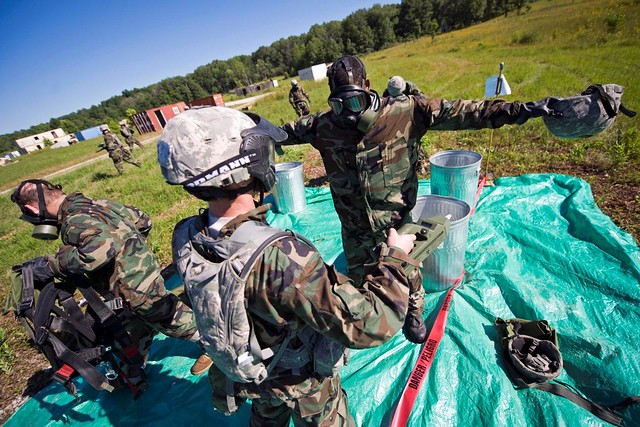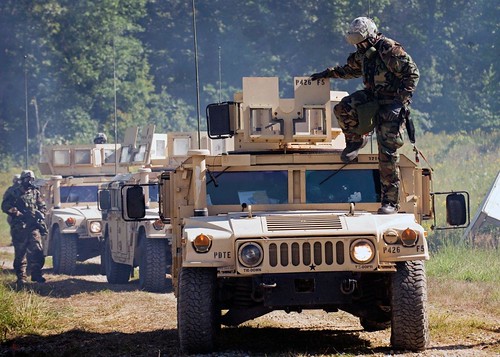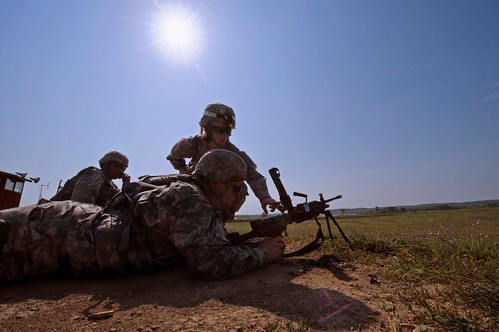Story and photos by John Crosby, Atterbury-Muscatatuck Public Affairs
[caption id="" align="aligncenter" width="576"]

Kentucky National Guard Soldiers of the 103rd Chemical Battalion practice chemical decontamination during a simulated chemical weapons attack at Camp Atterbury, near Edinburgh, Ind., July 25. The battalion wide exercise was the culmination of two weeks of annual training. (Photo by John Crosby, Atterbury-Muscatatuck Public Affairs)
EDINBURGH, Ind. -- The Kentucky National Guard's 103rd Chemical Battalion conducted decontamination training at Camp Atterbury, near Edinburgh, Ind., July 25.
This culminating event, involving search and extraction, reconnaissance and decontamination teams, is the result of two weeks of annual training held here.
[caption id="" align="alignright" width="350"]

Kentucky National Guard Soldiers of the 103rd Chemical Battalion dismount their Humvees during a chemical decontamination exercise at Camp Atterbury, near Edinburgh, Ind., July 25. The battalion wide exercise was the culmination of two weeks of annual training. (Photo by John Crosby, Atterbury-Muscatatuck Public Affairs)
These troops conducted traditional Soldier skills training including weapons ranges and room clearing, as well as occupational specific training. Additionally, they conducted drivers familiarization training on the M113 Armored Personal Carrier equipped with an M58 Wolf Smoke Generator System. This system creates large plumes of smoke to provide concealment to Soldiers on the battlefield.
"We've been doing a lot of training this past year on the vehicle, but this is the first time we've been able to really get some hands on driving time, seeing what the vehicle can and can't do and how it handles the terrain," said Spc. Chris Mocabee, Chemical Specialist with the 301st Chemical Company. "Basically, if you've got a unit coming across the hot zone, we can provide smoke to limit the enemies visibility and make sure our guys don't take any hits."
This annual training period is the unit's first since 2008. The unit deployed in support of Operation Iraqi Freedom from 2009-2010. In 2011 and 2012, the battalion trained to become part of the Kentucky Chemical, Biological, Radiological, Nuclear and High Yield Explosive Enhanced Response Force Package.
[caption id="" align="alignleft" width="350"]

Kentucky National Guard Pfc. Kathrine Hix, Richmond, Ky., chemical specialist in Headquarters and Headquarters Detachment, 103rd Chemical Battalion inspects the chamber of an M249 Squad Automatic Weapon at Camp Atterbury, near Edinburgh, Ind., July 17. The battalion trained a variety of Soldier skills including the weapons ranges and room clearing operations, as well as occupational specialty specific training. (Photo by John Crosby, Atterbury-Muscatatuck Public Affairs)
"It's been about five years since we've been out here as a unit in this capacity, training our traditional National Guard mission," said 299th Chemical Company 1st Sgt. William Thompson Jr. "We've got so many new Soldiers in the unit, which is a plus when it comes to training because these younger guys have the fresh and latest techniques to share."
The culminating event began with a simulated chemical, biological, radiological, nuclear related incident, in which Soldiers were contaminated. The M113 tracked vehicles rushed to the scene and deployed smoke. Reconnaissance forces donning gas masks and full chemical suits took out to search for casualties. Search and extraction teams helped gather casualties and guided them and their vehicles to the decontamination area where they were methodically filtered and cleaned of the attack.
"The day has been good, they're operating smoothly now," said Thompson of his Soldiers. "They've come a long way since the beginning of the week."
Thompson added he hopes to return to Atterbury for annual training next year.